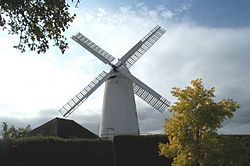Stone Cross Windmill facts for kids
Quick facts for kids Stone Cross Windmill |
|
|---|---|

The mill in 2007
|
|
| Origin | |
| Mill name | Stone Cross Mill White Mill Blackness Mill |
| Mill location | TQ 620 043 |
| Coordinates | 50°48′58″N 0°17′53″E / 50.816°N 0.298°E |
| Operator(s) | Stone Cross Mill Trust |
| Year built | 1876 |
| Information | |
| Purpose | Corn mill |
| Type | Tower mill |
| Storeys | Five storeys |
| No. of sails | Four sails |
| Type of sails | Patent sails |
| Windshaft | Cast iron |
| Winding | Fantail |
| No. of pairs of millstones | Three pairs |
Stone Cross Windmill is a very special old building in Stone Cross, East Sussex, England. It's a type of windmill called a tower mill. This mill has been carefully fixed up and is now open for people to visit and learn about. It was also known by other names, like Blackness Mill and the White Mill.
Contents
The Mill's Story
Building the Windmill
Stone Cross Windmill was built in 1876. A skilled mill builder named Stephen Neve from Warbleton designed and put together the machinery. The tall tower itself was built by a local bricklayer, Thomas Honeysett. All the parts inside that make the mill work came from a company called Phoenix Iron Foundry in Lewes.
Working Days and Changes
This windmill used the power of the wind to grind corn into flour for many years. In 1925, two of its large sails were blown off during a storm. Even with only two sails, it kept working by wind until 1937. During the Second World War, the mill was used as a lookout spot.
Saving the Mill
After it stopped working, there were plans to turn the mill into a house in 1962. However, Mr. Ron Hall, who owned the land, decided to save the mill instead. He started repairing it in 1966. By 1977, it looked much like it did when it stopped working, with two sails missing its fantail (the small windmill at the back that turns the main sails into the wind).
Bringing the Mill Back to Life
By the 1990s, the mill needed a lot more work. So, a group of people formed the Stone Cross Mill Trust in 1996. This trust is a charity, and their goal was to buy and fully restore the mill. They started the big restoration project in 1998. It was a huge success! By the year 2000, the mill was able to grind wholemeal flour again, just like it used to.
In 2005, the Trust received a special award from the Society for the Protection of Ancient Buildings. This award recognized their amazing work in bringing the mill back to full working order. Many groups helped pay for the restoration, including the Heritage Lottery Fund and local councils. More repairs happened in 2009 and 2011 when the sails and top of the mill were taken off for fixing. Stone Cross Mill even has a special friendship with another windmill called De Wachter in the Netherlands.
How the Windmill Works
Stone Cross Windmill is a five-storey building, meaning it has five levels inside. It has a platform around the first floor. The top of the mill is shaped like a dome and can turn to face the wind. This turning is done by a small windmill at the back called a fantail.
The mill has four large sails that catch the wind. These sails are connected to a strong cast iron shaft inside. A big iron wheel, about 8 feet 7 inches (2.6 meters) across, helps power the machinery. Inside, there are three pairs of millstones that grind the grain. The tower is wide at the bottom, about 16 feet 6 inches (5 meters) across, and gets narrower at the top, about 11 feet (3.3 meters) across. The whole tower is about 38 feet (11.5 meters) tall to the top edge.
People Who Ran the Mill
Here are the millers who worked at Stone Cross Windmill:
- Samuel Dallaway (1876 - 1878)
- Frederick Dallaway (1878 - 1895)
- Henry Dallaway (1895 - 1937)

